《微生物学 Microbiology》课程PPT教学课件(英文版)disorders associated with the immune system 1/2
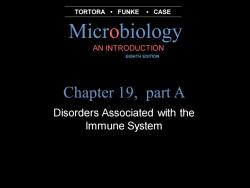
TORTORA·FUNKE·CASE Microbiology AN INTRODUCTION EIGHTH EDITION Chapter 19,part A Disorders Associated with the Immune System
Copyright © 2004 Pearson Education, Inc., publishing as Benjamin Cummings Microbiology B.E Pruitt & Jane J. Stein AN INTRODUCTION EIGHTH EDITION TORTORA • FUNKE • CASE Chapter 19, part A Disorders Associated with the Immune System
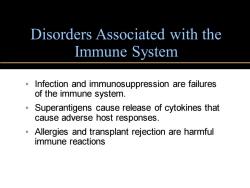
Disorders Associated with the Immune System Infection and immunosuppression are failures of the immune system. Superantigens cause release of cytokines that cause adverse host responses. Allergies and transplant rejection are harmful immune reactions
Disorders Associated with the Immune System • Infection and immunosuppression are failures of the immune system. • Superantigens cause release of cytokines that cause adverse host responses. • Allergies and transplant rejection are harmful immune reactions
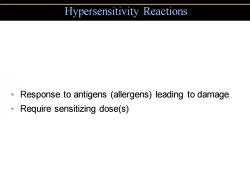
Hypersensitivity Reactions Response to antigens (allergens)leading to damage Require sensitizing dose(s)
• Response to antigens (allergens) leading to damage • Require sensitizing dose(s) Hypersensitivity Reactions
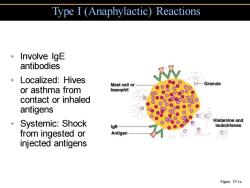
Type I (Anaphylactic)Reactions 。Involve IgE antibodies 。Localized:Hives Mast cell or Granule or asthma from basophil contact or inhaled antigens Systemic:Shock Histamine and IgE leukotrienes from ingested or Antigen E洲 injected antigens Figure 19.la
• Involve IgE antibodies • Localized: Hives or asthma from contact or inhaled antigens • Systemic: Shock from ingested or injected antigens Type I (Anaphylactic) Reactions Figure 19.1a

Type I (Anaphylactic)Reactions 。 Skin testing 。Desensitization Figure 19.3
• Skin testing • Desensitization Type I (Anaphylactic) Reactions Figure 19.3
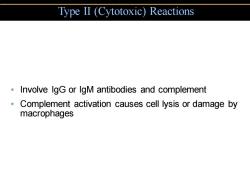
Type II (Cytotoxic)Reactions Involve IgG or IgM antibodies and complement Complement activation causes cell lysis or damage by macrophages
• Involve IgG or IgM antibodies and complement • Complement activation causes cell lysis or damage by macrophages Type II (Cytotoxic) Reactions
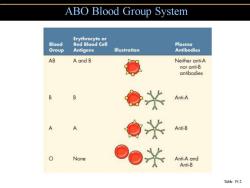
ABO Blood Group System Erythrocyte or Blood Red Blood Cell Plasma Group Antigens lllustration Antibodies AB A and B Neither anti-A nor anti-B antibodies B B 米 Anti-A A A Anti-B None Anti-A and Anti-B Table 19.2
ABO Blood Group System Table 19.2

Hemolytic Disease of the Newborn 0 0 e 0 8 ⊕ Figure 19.4
Hemolytic Disease of the Newborn Figure 19.4
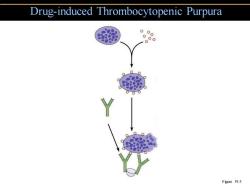
Drug-induced Thrombocytopenic Purpura 0 00 Figure 19.5
Drug-induced Thrombocytopenic Purpura Figure 19.5

Type III (Immune Complex)Reactions IgG antibodies and antigens form complexes that lodge in basement membranes. Basement membrane of blood vessel Immune complexes are deposited in wall Ag of blood vessel. Neutrophils ②Presence of immune Enzymes released complexes activates from neutrophils complement and cause damage to attracts inflammatory endothelial cells cells such as of basement Endothelial. neutrophils. membrane. cell Figure 19.6
• IgG antibodies and antigens form complexes that lodge in basement membranes. Type III (Immune Complex) Reactions Figure 19.6
按次数下载不扣除下载券;
注册用户24小时内重复下载只扣除一次;
顺序:VIP每日次数-->可用次数-->下载券;
- 《微生物学 Microbiology》课程PPT教学课件(英文版)classification of microrganisms 2/2.ppt
- 《微生物学 Microbiology》课程PPT教学课件(英文版)classification of microrganisms 1/2.ppt
- 《微生物学 Microbiology》课程PPT教学课件(英文版)chemical principles 2/2.ppt
- 《微生物学 Microbiology》课程PPT教学课件(英文版)chemical principles 1/2.ppt
- 《微生物学 Microbiology》课程PPT教学课件(英文版)biotechnology and recombinant DNA 2/2.ppt
- 《微生物学 Microbiology》课程PPT教学课件(英文版)biotechnology and recombinant DNA 1/2.ppt
- 《微生物学 Microbiology》课程PPT教学课件(英文版)applied and industrial microbiology.ppt
- 《微生物学 Microbiology》课程PPT教学课件(英文版)antimicrobial drugs 2/2.ppt
- 《微生物学 Microbiology》课程PPT教学课件(英文版)antimicrobial drugs 1/2.ppt
- 云南农业大学:《微生物学》课程教学资源(PPT课件)第四章 微生物的生长和环境条件.ppt
- 云南农业大学:《微生物学》课程教学资源(PPT课件)第六章 真核微生物.ppt
- 云南农业大学:《微生物学》课程教学资源(PPT课件)第八章 微生物的生态.ppt
- 云南农业大学:《微生物学》课程教学资源(PPT课件)第五章 原核生物.ppt
- 云南农业大学:《微生物学》课程教学资源(PPT课件)第三章 细菌的遗传和变异.ppt
- 云南农业大学:《微生物学》课程教学资源(PPT课件)第七章 病毒.ppt
- 云南农业大学:《微生物学》课程教学资源(PPT课件)绪论(主讲:刘雅婷).ppt
- 云南农业大学:《微生物学》课程教学资源(PPT课件)第二章 微生物的营养和代谢.ppt
- 云南农业大学:《微生物学》课程教学资源(PPT课件)第一章 微生物的细胞.ppt
- 《微生物学》课程教学资源(PPT课件)第八章 微生物生态.ppt
- 《微生物学》课程教学资源(PPT课件)第九章 传染与免疫.ppt
- 《微生物学 Microbiology》课程PPT教学课件(英文版)disorders associated with the immune system 2/2.ppt
- 《微生物学 Microbiology》课程PPT教学课件(英文版)domains bacteria archaea 1/5.ppt
- 《微生物学 Microbiology》课程PPT教学课件(英文版)domains bacteria archaea 2/5.ppt
- 《微生物学 Microbiology》课程PPT教学课件(英文版)domains bacteria archaea 3/5.ppt
- 《微生物学 Microbiology》课程PPT教学课件(英文版)domains bacteria archaea 4/5.ppt
- 《微生物学 Microbiology》课程PPT教学课件(英文版)domains bacteria archaea 5/5.ppt
- 《微生物学 Microbiology》课程PPT教学课件(英文版)environmental microbiology 1/3.ppt
- 《微生物学 Microbiology》课程PPT教学课件(英文版)environmental microbiology 2/3.ppt
- 《微生物学 Microbiology》课程PPT教学课件(英文版)environmental microbiology 3/3.ppt
- 《微生物学 Microbiology》课程PPT教学课件(英文版)functional anatomy of prokaryotic and eukaryotic cells 1/2.ppt
- 《微生物学 Microbiology》课程PPT教学课件(英文版)functional anatomy of prokaryotic and eukaryotic cells 2/2.ppt
- 《微生物学 Microbiology》课程PPT教学课件(英文版)fungi algae protozoa and helminths 1/4.ppt
- 《微生物学 Microbiology》课程PPT教学课件(英文版)fungi algae protozoa and helminths 2/4.ppt
- 《微生物学 Microbiology》课程PPT教学课件(英文版)fungi algae protozoa and helminths 3/4.ppt
- 《微生物学 Microbiology》课程PPT教学课件(英文版)fungi algae protozoa and helminths 4/4.ppt
- 《微生物学 Microbiology》课程PPT教学课件(英文版)microbial diseases of digestive system 1/3.ppt
- 《微生物学 Microbiology》课程PPT教学课件(英文版)microbial diseases of digestive system 2/3.ppt
- 《微生物学 Microbiology》课程PPT教学课件(英文版)microbial diseases of digestive system 3/3.ppt
- 《微生物学 Microbiology》课程PPT教学课件(英文版)microbial diseases of the cardiovascalar and lymphatic systems 1/3.ppt
- 《微生物学 Microbiology》课程PPT教学课件(英文版)microbial diseases of the cardiovascalar and lymphatic systems 2/3.ppt
